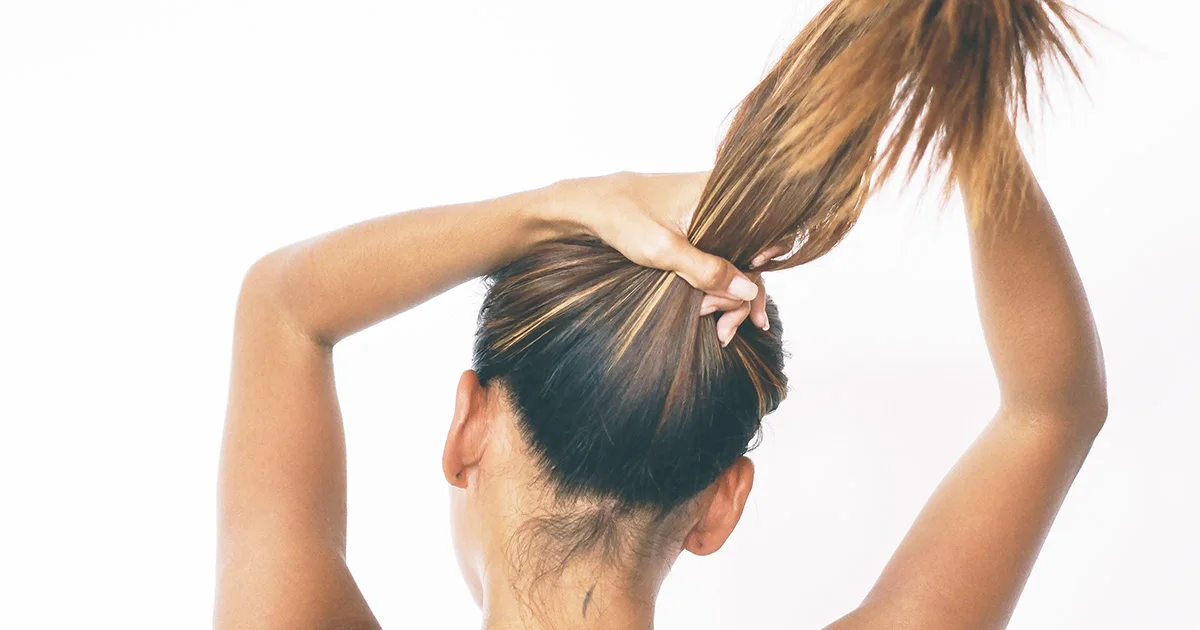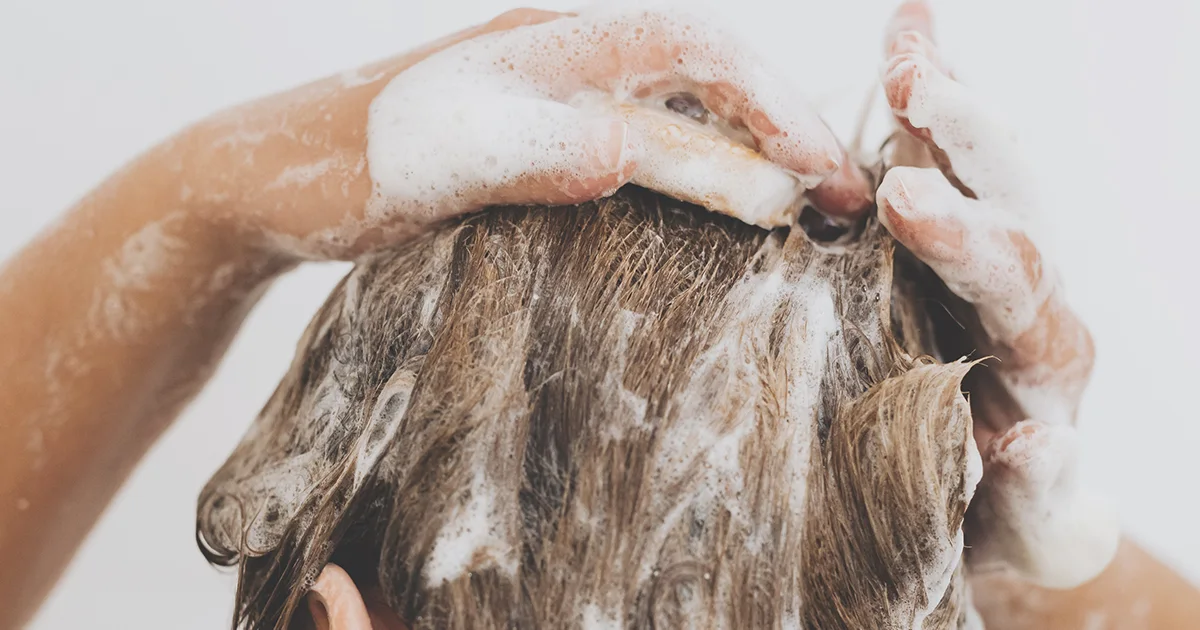Here's what we'll cover
Here's what we'll cover
There are few things we humans fear more than leaving a social event only to find that something was going on with us from the head up that people may have been staring at. An errand salad green in the teeth, a dribble of mustard on the side of the mouth, or visible dandruff flakes in our hairline are all perfectly normal things to happen to us, and yet it can make even some of the most confident people want to rewind the tape of the entire night. We can’t speak to the stats of how often people get food on their face (but, you know, it’s common), but we do know that up to half of the world’s population post-puberty experiences dandruff (Turner, 2012).
We’re all familiar with those itchy white flakes, but there’s some general confusion about what dandruff is exactly. Dandruff is easily confused for a dry scalp—unless you know what those pesky flakes are telling you. Although there are more subtle differences, flakes from dandruff are generally larger pieces of skin, can be white or yellowish, and are oily. Flaking due to dry skin on the scalp is usually seen as tiny pieces that are white.
What causes dandruff?
The yeast-like fungus Malassezia is a common cause of dandruff. This fungus is attracted to the oil glands on your scalp, face, and upper trunk. It can cause dandruff but may also make other existing skin conditions worse. Since Malassezia likes oils, it takes up fatty acids from your oil glands and breaches the scalp skin barrier, leading to water loss that can cause the dryness and flakiness we associate with dandruff. But even though it’s notorious for causing those painful and irritating symptoms of dandruff such as redness, itching, and flaking, they tend to be less severe than when this skin condition is caused by seborrheic dermatitis (Wuthi-udomlert, 2011).
The most common cause of dandruff is, as you likely guessed, seborrheic dermatitis. This skin condition, though it can and often does affect the scalp, may also cause symptoms anywhere you have oil glands, like your eyebrows, groin, armpits, and even alongside the sides of your nose. This type of dermatitis causes your skin to become oily, red, and scaly, and the flakes it causes can be either yellow or white. Even babies get seborrheic dermatitis, and in infants, it’s called cradle cap.
Dandruff may also be due to other forms of dermatitis such as eczema or psoriasis, diet, or an allergic reaction to hair products—though these causes are far less common. If you’re suffering from dandruff, it may be worth getting a blood test to check for nutrient deficiencies as low levels of riboflavin (vitamin B2), niacin (vitamin B3), zinc, and pyridoxine (vitamin B6) are associated with seborrheic dermatitis (Borda, 2015).
How to use coconut oil to treat dandruff
There really isn’t a wrong way to add coconut oil to your hair care routine as long as you’re getting to the root of the issue (the scalp) and cleaning it out when you’re done conditioning since extra oil isn’t going to help the situation. Using one or two tablespoons of coconut oil, work into your scalp, and let it sit for up to an hour for an easy, at-home dandruff remedy. When you’ve given this dandruff treatment time to soak in, rinse it out with gentle shampooing. Repeat this process twice a week.
You may also want to try mixing essential oils into your coconut oil, which can act as a carrier, delivering the essential oils to your skin in the right concentration. Some of these oils—such as eucalyptus oil, lemongrass oil, and tea tree oil —show promise in treating dandruff (Selvakumar, 2012; Chaisripipat, 2015; Satchell, 2002). Some of them may help by moisturizing flaky skin, while others boast antibacterial or antifungal properties that can address the root problem. By mixing them with coconut oil in your biweekly treatment, you’ll get more powerful effects.
Risks and considerations
You should avoid using coconut oil in your hair if you have tree nut allergies. If you do not, there are few risks associated with using coconut oil as a mask for your scalp. There is a chance that your hair will feel greasy, especially if you don’t get all of the coconut oil out when you shampoo. Since dandruff is associated with excess oil, this could potentially make your dandruff worse. But as long as you gently but effectively wash out the coconut oil, this shouldn’t be an issue. If used and rinsed out correctly, coconut oil may even act as a deep conditioner, leaving you with healthy hair.
How effective is coconut oil for dandruff?
Mild cases of dandruff may be effectively treated with coconut oil, though some people may need over-the-counter dandruff shampoos. In some rare cases, dandruff needs the attention of a board-certified dermatologist who can address an underlying skin issue that may be the cause. But there are cases in which coconut oil can help.
Dry skin can make dandruff worse, though again, dry scalp is different from dandruff. One study found that coconut oil was just as effective at treating dry skin as mineral oil (Agero, 2004). Dandruff may also be exacerbated by eczema. Applying coconut oil for eight weeks reduced symptoms of atopic dermatitis, a type of eczema, by 68% in one study (Evangelista, 2014). So coconut oil may at least reduce the severity of your dandruff symptoms, especially the itchiness. There is also some evidence that this tropical oil has antimicrobial and antifungal properties. Although a study tested its abilities on Candida, coconut oil may be able to help counter an overgrowth of the yeast-like fungus Malassezia that’s behind some people’s dandruff thanks to these properties (Ogbolu, 2007).
Other remedies for dandruff
Over-the-counter (OTC) anti-dandruff shampoo is the most well-known solution. But there are other options for people hoping to clear their scalp through another route. For those who want to use something more natural, there are home remedies for dandruff that have scientific backing, such as baking soda, aloe vera, apple cider vinegar, and the essential oils already mentioned. Some of these natural remedies also have anti-inflammatory properties that can address the redness that some people experience with dandruff.
Many dandruff shampoos use an antifungal agent such as zinc pyrithione (also called pyrithione zinc), selenium sulfide, or ketoconazole as their active ingredient. You may also see salicylic acid, which can help strip excess scaling from your scalp before it gets the chance to turn into dandruff flakes. But you may want to test your reaction to salicylic acid before committing to a bottle, since it may dry the skin and cause excess flaking in some people. If you’ve tried OTC options before and haven’t seen results, talk to your dermatologist. Stronger anti-dandruff shampoos are also available as a prescription.
DISCLAIMER
If you have any medical questions or concerns, please talk to your healthcare provider. The articles on Health Guide are underpinned by peer-reviewed research and information drawn from medical societies and governmental agencies. However, they are not a substitute for professional medical advice, diagnosis, or treatment.
Agero, A. L., & Verallo-Rowell, V. (2008). P15A randomized double-blind controlled trial comparing extra-virgin coconut oil with mineral oil as a moisturizer for mild to moderate xerosis. Contact Dermatitis , 50 (3), 183–183. doi: 10.1111/j.0105-1873.2004.00309ew.x. Retrieved from https://www.ncbi.nlm.nih.gov/pubmed/15724344
Borda, L. J., & Wikramanayake, T. C. (2015). Seborrheic Dermatitis and Dandruff: A Comprehensive Review. Journal of Clinical and Investigative Dermatology , 3 (2). doi: 10.13188/2373-1044.1000019. Retrieved from https://www.ncbi.nlm.nih.gov/pmc/articles/PMC4852869/
Chaisripipat, W., Lourith, N., & Kanlayavattanakul, M. (2015). Anti-dandruff Hair Tonic Containing Lemongrass (Cymbopogon flexuosus) Oil. Complementary Medicine Research , 22 (4), 226–229. doi: 10.1159/000432407. Retrieved from https://www.ncbi.nlm.nih.gov/pubmed/26566122
Evangelista, M. T. P., Abad-Casintahan, F., & Lopez-Villafuerte, L. (2013). The effect of topical virgin coconut oil on SCORAD index, transepidermal water loss, and skin capacitance in mild to moderate pediatric atopic dermatitis: a randomized, double-blind, clinical trial. International Journal of Dermatology , 53 (1), 100–108. doi: 10.1111/ijd.12339. Retrieved from https://www.ncbi.nlm.nih.gov/pubmed/24320105
Ogbolu, D., Oni, A., Daini, O., & Oloko, A. (2007). In Vitro Antimicrobial Properties of Coconut Oil on Candida Species in Ibadan, Nigeria. Journal of Medicinal Food , 10 (2), 384–387. doi: 10.1089/jmf.2006.1209. Retrieved from https://www.ncbi.nlm.nih.gov/pubmed/17651080
Satchell, A. C., Saurajen, A., Bell, C., & Barnetson, R. S. (2002). Treatment of dandruff with 5% tea tree oil shampoo. Journal of the American Academy of Dermatology , 47 (6), 852–855. doi: 10.1067/mjd.2002.122734. Retrieved from https://www.ncbi.nlm.nih.gov/pubmed/12451368
Selvakumar, P., Naveena, B. E., & Prakash, S. (2012). Studies on the antidandruff activity of the essential oil of coleus amboinicus and eucalyptus globulus. Asian Pacific Journal of Tropical Disease , 2 . doi: 10.1016/s2222-1808(12)60250-3. Retrieved from https://www.sciencedirect.com/science/article/pii/S2222180812602503
Turner, G. A., Hoptroff, M. R., & Harding, C. (2012). Stratum corneum dysfunction in dandruff. International Journal of Cosmetic Science , 34 (4), 298–306. doi: 10.1111/j.1468-2494.2012.00723.x. Retrieved from https://www.ncbi.nlm.nih.gov/pmc/articles/PMC3494381/
Wuthi-udomlert, M., Chotipatoomwan, P., Panyadee, S., & Gritsanapan, W. (2011). Inhibitory Effect of Formulated Lemongrass Shampoo on Malassezia Furfur: A Yeast Associated with Dandruff. Southeast Asian Journal of Tropical Medicine and Public Health , 42 (2), 363–369. Retrieved from https://www.tm.mahidol.ac.th/seameo/publication.htm










